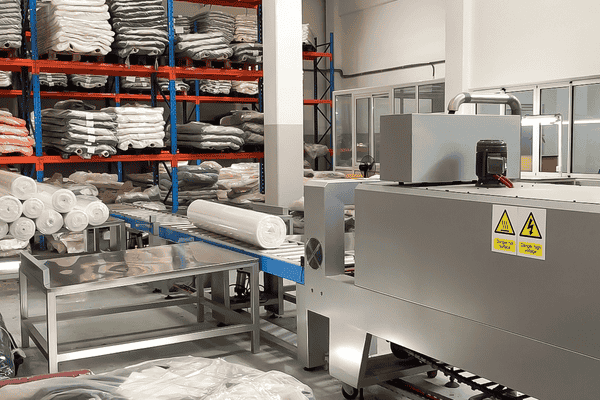
Introduction
In the ever-evolving textile industry, the versatility of packing machines has become a crucial factor in meeting diverse production needs. With varying fabric types and distinct production demands, the machinery must be adaptable to ensure both efficiency and quality. In this article, we’ll explore how modern packing machines are designed to handle different fabric types and accommodate various production requirements.
What Makes Packing Machines Versatile?
Packing machines today are engineered with flexibility in mind. One key feature that makes them adaptable is the ability to adjust settings according to specific needs. From controlling the speed of operation to customizing packing sizes, these machines are equipped to deal with a wide range of fabric types and production requirements.
The Role of Adjustable Settings
Adjustable settings in packing machines allow operators to tailor the machine’s functions based on the task at hand. This can include variations in speed, pressure, and packing density, all of which contribute to more efficient handling of different fabrics.
The Significance of Variable Speed Control
One of the standout features of modern packing machines is variable speed control. This allows operators to adjust the speed at which the machine operates, ensuring that fabrics of varying thicknesses, textures, and sensitivities are packed with precision. Variable speed control can be especially useful when transitioning between different fabric types on a production line, minimizing damage and maintaining quality.
Handling Different Types of Fabrics
Not all fabrics are created equal. The textile industry involves a wide range of materials, from delicate silks to heavy-duty denim, each with its own unique handling requirements. Fortunately, packing machines are designed to manage this variety with ease.
Delicate Fabrics
Delicate fabrics such as silk, chiffon, and lace require gentle handling to avoid damage. Packing machines equipped with soft touch or low-speed settings ensure these fabrics are packed without tension or creasing, preserving their delicate nature.
Heavy-Duty Fabrics
On the opposite end of the spectrum, heavy-duty fabrics like denim, canvas, and upholstery materials require more robust handling. Packing machines designed for these fabrics feature stronger motors, higher packing pressures, and adjustable tension controls to ensure the fabric is packed securely without compromising its integrity.
Stretchable Fabrics
Stretch fabrics, such as spandex, lycra, or jersey, are more elastic and prone to distortion if not handled properly. Packing machines designed for stretchable fabrics provide controlled tension settings and slower packing speeds, ensuring the fabric maintains its shape and elasticity during the packing process.
Specialty Fabrics (e.g., Wool, Denim)
Certain fabrics, like wool or denim, require specialized handling due to their unique textures and weights. Packing machines designed for specialty fabrics often feature customized rollers, heating elements, or pressing mechanisms to deal with these materials effectively.
Accommodating Various Production Demands
Production lines in textile manufacturing vary widely depending on the scale and goals of the operation. Whether a factory is focused on high-speed mass production or custom, low-volume orders, packing machines are designed to meet these diverse needs.
High-Speed Production Lines
For manufacturers that focus on high-volume output, packing machines can be adjusted for maximum speed. Variable speed control plays a crucial role here, allowing operators to increase the machine’s pace without sacrificing packing quality.
Low-Volume, High-Quality Production
On the other hand, some textile producers prioritize quality over quantity, creating low-volume but high-quality fabrics. Packing machines used in these operations can be set to slower speeds and more precise packing techniques, ensuring the fabric’s quality is maintained throughout the process.
Custom Production Runs
For textile manufacturers involved in niche markets or custom fabric runs, packing machines can be fine-tuned to meet specific needs. These machines can be programmed to accommodate different fabric sizes, weights, and types, providing the flexibility needed for bespoke orders.
How Variable Speed Control Enhances Performance
The ability to adjust machine speed is not just about moving fabrics faster—it’s about matching the machine’s performance to the fabric’s needs.
Adjusting Speed Based on Fabric Type
Packing machines with variable speed control can adapt to the type of fabric being processed. For example, delicate materials can be packed at slower speeds, while more robust fabrics can be processed at higher speeds without causing damage.
The Effect of Speed Control on Efficiency and Quality
In high-speed production lines, speeding up the packing process can improve throughput. However, when dealing with delicate or sensitive fabrics, slowing down the machine ensures better handling and reduced chances of damage. Thus, variable speed control ensures a balance between efficiency and care.
Balancing Speed and Care for Delicate Materials
Packing delicate fabrics at too high a speed can lead to creasing, stretching, or even tearing. Machines with adjustable speeds allow operators to slow down when necessary, striking the perfect balance between speed and quality.

User-Friendly Interface: Simplifying Machine Operation
One of the most important features of modern packing machines is the user-friendly interface. Operators, whether experienced or new to the field, can easily adjust settings and control the machine’s performance.
Intuitive Controls for Different Users
Modern packing machines often feature digital interfaces with touchscreens, allowing for easy operation. Operators can adjust settings such as speed, pressure, and packing density with just a few taps, reducing the learning curve for new employees.
Training and Ease of Use for Operators
Training operators to use packing machines is a breeze, thanks to their intuitive design. Most machines come with clear visual indicators and preset options that simplify the setup process, making it easier for workers to produce high-quality results.
Quality Control and Consistency Across Fabrics
One of the most important factors in textile production is ensuring consistent quality. Packing machines that can handle different fabric types without sacrificing quality are crucial to maintaining high standards in production.
Ensuring Consistent Packing for All Fabric Types
Packing machines are designed to ensure that fabrics of all types are packed consistently. This is achieved through adjustable settings, automated features, and real-time monitoring systems that prevent packing errors and maintain uniformity across different materials.
Preventing Damage During the Packing Process
Consistent, gentle handling reduces the risk of fabric damage during packing. By fine-tuning machine settings such as speed and tension, packing machines prevent stretching, tearing, or other damage that could arise from improper handling.
How Adaptability Will Continue to Evolve
As textile manufacturers demand more flexibility and efficiency, packing machines will become even more adaptable. The ability to quickly switch between fabric types, adjust speeds, and customize settings will be crucial in maintaining competitiveness in the global textile market.
Conclusion
In conclusion, modern packing machines are more than capable of handling different fabric types and production requirements. With features like adjustable settings, variable speed control, and user-friendly interfaces, these machines offer flexibility and efficiency, ensuring that manufacturers can meet diverse needs without sacrificing quality. As technology advances, packing machines will continue to evolve, making them even more versatile and integral to the textile production process.








